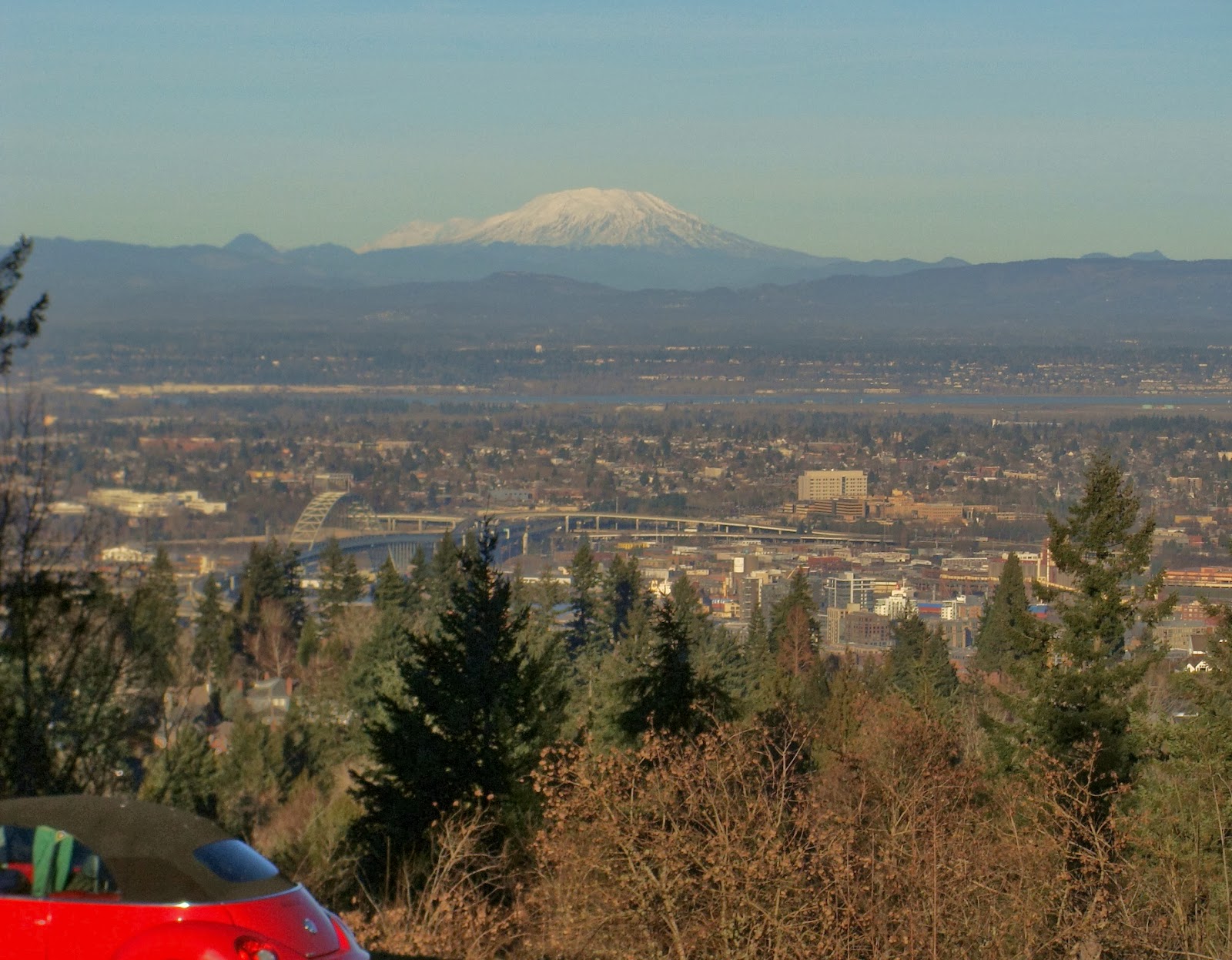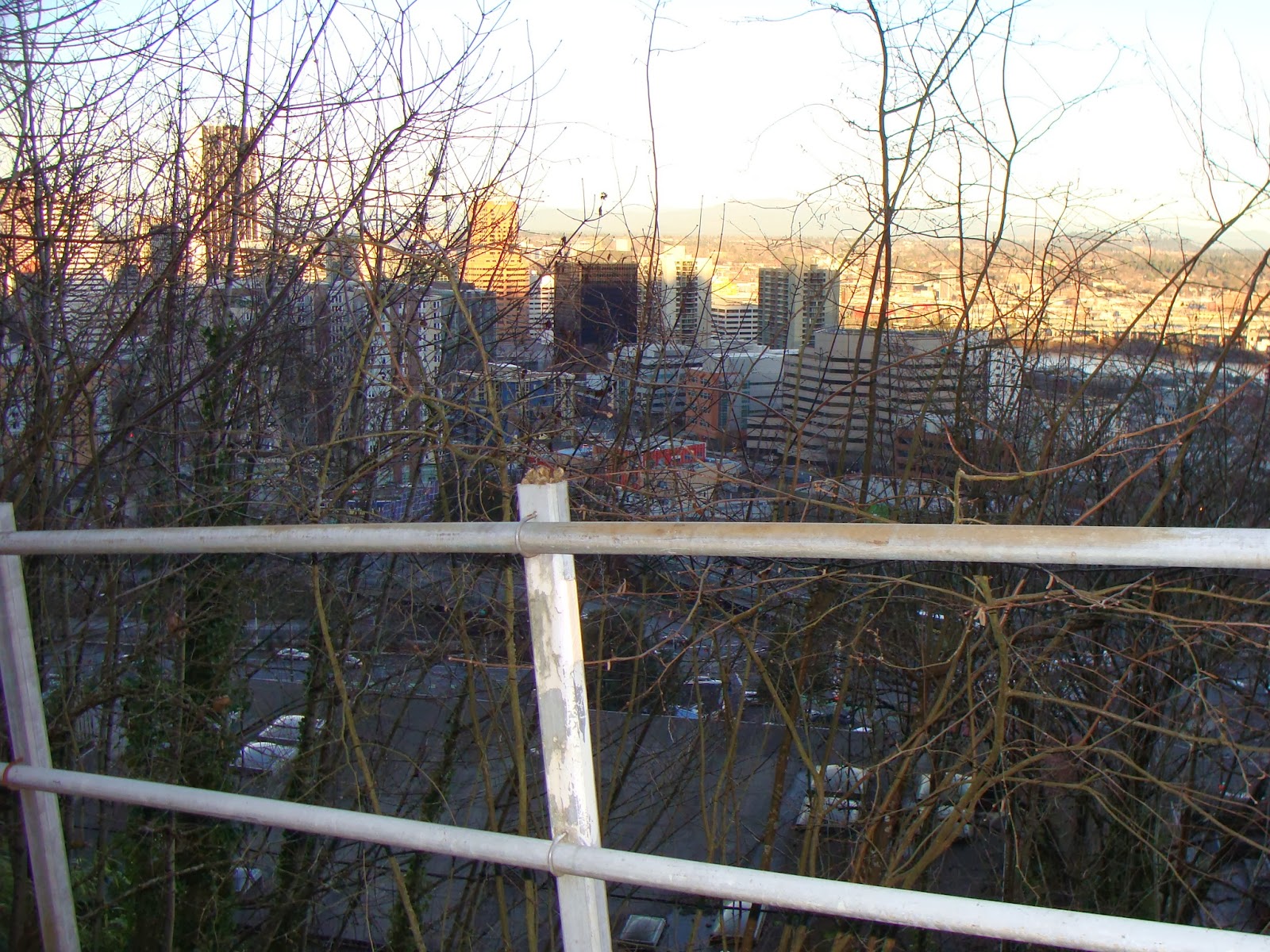Everyone should visit Oregon's State Capital City, Salem, at least once! And here is a walk to go on once you get there, taking in Oregon's Capitol and its Mall, a beautiful district of historic houses, and Oregon's historic State Hospital and its grounds. The walk is 3.6 miles and is entirely flat.
Start at Oregon's State Capitol, seat of government for the state, on the Court Street side of the building. The building was completed in 1938, and looks much different from the classic statehouse capitol dome seen in many other state capitals. Oregon used to have a classic capitol dome, but the building burned to the ground in 1935, leading to this structure. The "golden pioneer" stands atop the "dome," and at least until recently you could go on a special capitol tour which included steps up to the top. I don't know if you still can, because in 2013 some knuckleheaded protesters went on the tour and then rappeled down from the top, unfurling a protest banner. If you're interested in trying to take a tour, call the visitor's center to see if any are scheduled before or after the walk.
Continue east on Court Street, then cross 12th Street and the busy Southern Pacific Railroad tracks. Stay on the left side of the street, because Court is a one-way couplet that curves to the right to meet State Street at 13th Street, and a pedestrian crossing on the right side of the street is difficult. Continue onto what is now a very quiet Court Street, and you will be in the midst of Salem's Court-Chemeketa Streets Historic District, full of beautiful old homes. At 1467 Court Street, on the left side of the street, is the Griffith House, built in 1895.

At 1517 Court Street, on the left side of the street, is the beautiful Ashby-Durbin house, constructed in 1892, and as far as I can figure out the oldest residence in the district that is located on its original building site. There are some older homes on the street, but they were moved to their current sites at a later date. If you are interested in any of the other houses you will be passing by, this webpage contains all the information you will need.
 Continue on Court Street across busy 17th Street - the street ends at 18th Street. But this pedestrian bridge on the left side of the street will allow you to cross Mill Creek, and continue on Court Street to 20th Street, where you turn left. Continue on 20th Street past McRae Park, and turn right on Breyman Street. Follow the street to its end on 24th Street, cross the street, head left for a couple hundred feet, and enter the Oregon State Hospital grounds to the right.
Continue on Court Street across busy 17th Street - the street ends at 18th Street. But this pedestrian bridge on the left side of the street will allow you to cross Mill Creek, and continue on Court Street to 20th Street, where you turn left. Continue on 20th Street past McRae Park, and turn right on Breyman Street. Follow the street to its end on 24th Street, cross the street, head left for a couple hundred feet, and enter the Oregon State Hospital grounds to the right.The main 1883 building is still off to the east, but before you get there you will walk through the leafy grounds, past several very nice old homes that are part of the hospital. Underneath these placid lawns is rumored to be a tunnel that goes all the way back to the State Capitol! A legislature and an insane asylum would seem to be a perfect match, but the actual existence of such a tunnel is debatable - I've heard individuals who say they've actually seen it, and also heard individuals claiming it's a complete myth.
And then you will see ahead the grand Kirkbride Building, recently restored and upgraded. Inside is the unique Museum of Mental Health, open limited hours, but worth a visit if your walk and the open hours overlap. The State Hospital has a long and difficult history. It received some celluloid fame as the film location of One Flew Over the Cuckoo's Nest, Oscar winner for best picture in 1975, based upon Ken Kesey's famous novel of the same name.
Continue north from the Kirkbride Building to Center Street, and then start heading back west (to the left). Walk along busy Center Street (originally named Asylum Avenue until abutting property owners in the late 19th century objected!) to Breys Avenue, where you will turn right, and then left on "B" Street. You will once again cross 17th Avenue, through neighborhoods with attractive pre-World War II homes.
Once again be careful crossing busy 17th Street. At 14th Street, turn right and you will see North Salem High School, built in 1937 (one year before the State Capitol), but in a quite different colonial style that makes the building look older.
An interesting bit of trivia: North Salem High School was, before 1954, merely "Salem" High School, the only one in town (there are now six). When a new high school was built on the south side of town in 1954, the school was renamed, and, if you look closely above the entrance, you can see how the "North" was cleverly added to the entrance.
Where 14th Street meets "D" Street, turn left. You will once again cross the railroad tracks, pass a middle school on your right, and then cross Capitol Street. The next building, on your right, is the imposing Oregon State Archives.
The street beyond the archives building is Summer Street - here you turn left. After the archives you will cross Mill Creek. There's an awful lot of water in this "creek," and it turns out there's a reason for that - it is the beneficiary of a diversion upstream from the North Santiam River. The creek, as befits its name, was the site of early grist mills, but now serves mainly to occasionally flood central Salem. Here there's a nice park area along the creek between Summer and Capitol Streets.
Looking ahead, you view the Capitol Mall, with the end of your walk in sight. On either side of Summer Street, and then the Mall itself after Center Street, are a series of buildings representing typical government administrative architecture, some better looking than others, but none presenting a unified whole. The "brutalist" Department of Revenue building on your left between Marion and Center Streets is particularly ugly, while the Transportation building the next block down on the left (between Center and Chemeketa) is in the same art deco style as the State Capitol, and was recently completely retrofitted into a LEED "platinum" designated structure (which means it is extremely energy-efficient). The Mall itself has an interesting sculpture (pictured), and some other markers of interest inlaid in the sidewalks.
























